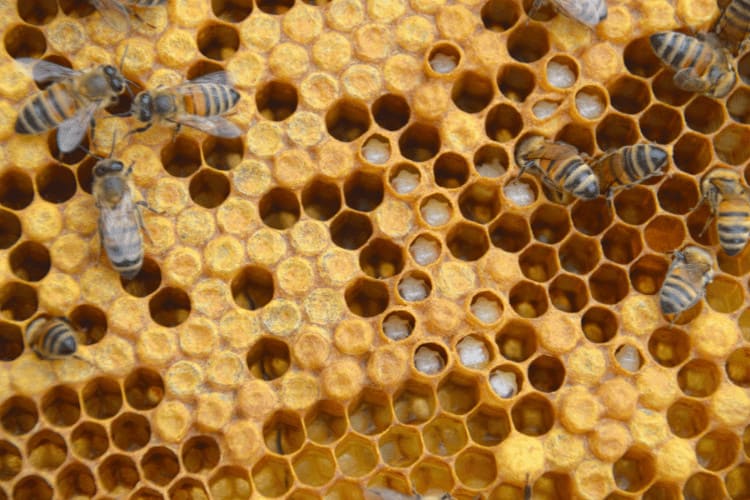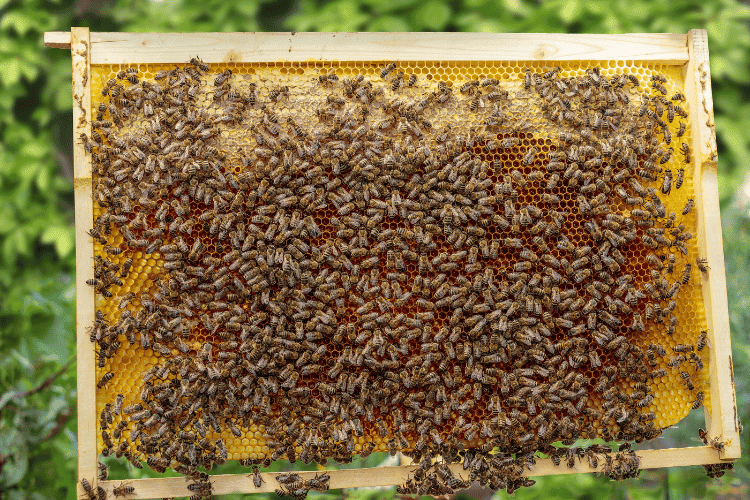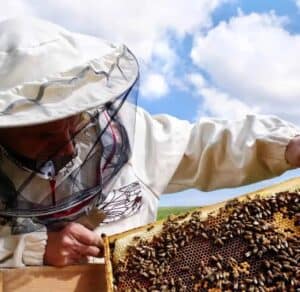Capped Brood vs Capped Honey: A Beekeeper’s Guide
Capped brood and capped honey are two of the most important components of a beehive.
Capped brood refers to the cells that contain developing bees, while capped honey refers to the cells that contain the hive’s food stores.
In this guide, we’ll explore the physical differences between capped brood vs capped honey, as well as how to tell the difference between the two. we’ll also discuss the implications of not being able to tell the two apart.
What Is a Capped Brood?

Capped brood describes the cells in a beehive that contain developing bees that have been capped with wax. Worker bees do all the capping which helps to protect the developing bees and keep them warm.
You’ll notice that the capped brood is typically found in the center of the hive, where it’s warmest.
The color of capped brood varies depending on the age of the bee. Freshly capped brood is typically a light yellow color, while older brood is a darker brown color.
The texture of capped brood is also slightly different, with freshly capped brood being more soft and pliable, while older brood is more hard and brittle. You can spot that right away.
Capped brood is an important part of the beehive, as it’s where the new bees are developed. If the capped brood is damaged or destroyed, it can have a negative impact on the hive’s ability to produce new bees.
What Is Capped Honey?
Capped honey is a term we use to describe the cells in a beehive that contain honey that has been capped with a layer of wax. Worker bees cap these cells to protect the honey from spoiling and keep it from drying out.
Capped honey is typically found in the outer edges of the hive, where it’s cooler. The color of capped honey varies depending on the type of flower nectar that the bees have collected, the time of year, and the age of the honey.
Honey from clover is typically a light yellow color, while honey from wildflowers is typically a darker brown color. Honey can also become darker over time as it ages.
If you look closely, you’ll see that the texture of capped honey is also slightly different, with clover honey being more smooth and runny, while wildflower honey is more thick and viscous.
Capped honey is an important part of the beehive, along with royal jelly and bee bread, as it’s the hive’s food store. If capped honey is damaged or destroyed, it can have a negative impact on the hive’s ability to survive the winter.
Why Is It Important to Be Able to Tell the Difference?
It’s important for us, beekeepers, to be able to tell the difference between capped brood and capped honey, as mishandling either could have dire consequences for the hive.
Harvesting Capped Brood Can Kill the Developing Bees
The capping on brood cells is made of wax and propolis, and it helps to protect the developing bees from the elements and from predators.
If you remove the capping, the bees inside will be exposed and vulnerable. In some cases, the bees may even die from the cold or from dehydration.
Leaving Capped Honey in the Hive Can Wipe Out the Colony
It’s important to harvest capped honey from the hive before it can ferment, attract pests and predators, overheat, or harbor disease.
The amount of honey that you need to leave in the hive for the bees to survive will vary depending on the climate and the strength of the colony. A good rule of thumb is to leave enough honey for the bees to survive for at least 6 weeks without any nectar flow.
Leaving capped honey unharvested can lead to:
- Fermentation: Uncapped honey isn’t completely dry. Its water content is about 18-20%, which is enough for fermentation to occur if the honey isn’t stored properly. Fermented honey can be toxic to bees and can kill the colony.
- The attraction of pests and predators: Capped honey is a valuable food source for pests and predators, such as wax moths, ants, and bears. If there’s too much honey storage in the hive, it can attract these pests and predators, which can weaken or kill the colony.
- Overheating: In hot weather, capped honey can overheat in the hive. This can kill the bees and damage the honey.
- Disease: Capped honey can harbor disease-causing organisms, such as Nosema and chalkbrood. If these diseases are not controlled, they can kill the colony.
The Physical Differences Between Capped Brood and Capped Honey
It’s important to note that these are just general guidelines. The actual appearance of capped brood and capped honey can vary depending on a number of factors, such as the age of the bees, the type of flower nectar that the bees have collected, and the time of year.

Color
- Capped brood is typically a darker brown color, due to the wax capping that’s used to seal the cell. The wax capping is made from a mixture of beeswax and propolis, which is a resinous substance that bees collect from plants. The propolis gives the capping a darker color.
- Capped raw honey can vary in color depending on the type of flower nectar that the bees have collected. Honey from clover is typically a light yellow color, while honey from wildflowers is typically a darker brown color. The color of honey can also change over time as it ages.
Texture
- Capped brood is typically more textured than capped honey. This is because the wax capping on capped brood cells is thicker and more opaque than the wax capping on capped honey cells.
The texture of capped brood cells is also due to the fact that the bees often add propolis to the capping, which gives it a bumpy or raised appearance.
- Capped honey is typically smooth and shiny. This is because the wax capping on capped honey cells is thinner and more translucent. The honey inside the cell can also give the capping a slightly golden or amber hue.
Shape
- Both capped brood and capped honey cells are hexagonal in shape. This is because the bees build their cells in a hexagonal shape, which is the most efficient way to pack the cells together.
- The size of capped brood and capped honey cells is typically about 5mm in diameter. However, the size of the cells can vary depending on the species of bee and the age of the beehive. Also, whether or not these are drone cells.
Drone larvae are typically bigger, so their cells are bigger than worker cells. They’re often more bulging.
Location
- Capped brood is typically found in the center of the hive, where it is warmest. This is because the developing bees need a warm environment to grow and develop. That is unless you have queen excluders, which keep the queen bees in a different location.
Separating the Langstroth brood box and the honey supers by placing a queen excluder directs the baby bees to a different comb.
- Capped honey is typically found in the outer edges of the hive, where it’s cooler. This is because honey does not need to be kept as warm as brood. Additionally, the cooler temperatures in the outer edges of the hive help to preserve the honey.
How to Tell the Difference Between Capped Brood and Capped Honey?
There are a few ways you can tell the difference between capped brood and capped honey.
Visual Inspection
Capped brood is typically a darker brown color, while capped honey can vary in color depending on the type of flower nectar that the bees have collected.

Capped brood cells may also have a slightly raised bump in the center, due to the wax capping being thicker and more opaque than the wax capping on capped honey cells.
The color of honey can also change over time as it ages, so it is important to compare the color of the cell to the color of honey that you have harvested in the past.
Using a Magnifying Glass
A magnifying glass can help you to see the differences in color, texture, and shape between capped brood and capped honey.
You can also use a magnifying glass to look for the raised bump in the center of capped brood cells.
The wax capping on capped brood cells is also typically more textured than the wax capping on capped honey cells, due to the fact that the bees often add propolis to the capping on capped brood cells.
Breaking Open a Cell
If you’re still unsure, you can break open a cell to see what is inside. Capped brood will contain a developing bee, while capped honey will contain honey. However, it is important to note that this should only be done as a last resort, as it can damage the hive.
Conclusion
Capped brood and capped honey are two important components of a beehive. Capped brood is the cells that contain developing bees, while capped honey is the cells that contain the hive’s food store.
It’s important for beekeepers to be able to tell the difference between capped brood and capped honey, as harvesting capped brood can kill the developing bees, and leaving capped honey in the hive can starve the colony.
By following the guidelines in this article, you can ensure that the hives are healthy and productive.

Joseph Davis
My goal is to show that anyone can take up beekeeping and it can be a very rewarding hobby. I strive to share my experiences and answer any questions you may have.
